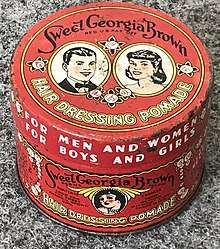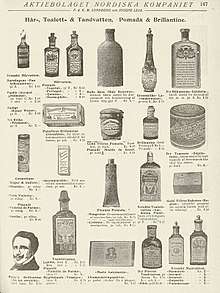Pomade
Pomade (/pɒˈmeɪd/; French pommade) is a greasy, waxy, or a water-based substance that is used to style hair. Pomade generally gives the user's hair a shiny and slick appearance. It lasts longer than most hair care products, and often requires multiple washes to completely remove. The original pomade of the eighteenth and nineteenth centuries consisted mainly of bear fat or lard. Lanolin, beeswax, and petroleum jelly have been used extensively in the manufacture of modern pomades. Stiffening properties of pomades make sculptured hairstyles such as the pompadour possible.
.jpg)

Origin of the name
The English word "pomade" is derived from French pommade meaning "ointment", itself arising from the Latin pomum (fruit, apple) via the Italian pomata or pomo (meaning "apple" — as the original ointment recipe contained mashed apples).[1] Modern pomades may contain fragrances, but they are usually not particularly fruity.
History

During the Roman era, soap was used as a pomade by some European tribes.[2] In the 19th century, bear fat was usually the main pomade ingredient.[3] In 1873 UK company Morgan's Pomade was established[4] selling Hair Darkening Pomade across the World. By the early 20th century, petroleum jelly,[5] beeswax, and lard were more commonly used.[6] Early 20th century examples of pomades include Murray's Superior Pomade (originating in 1925),[7] Sweet Georgia Brown Hair Dressing Pomade (originating in 1934)[8] and Royal Crown Pomade (originating in 1936). Dixie Peach Hair Pomade was popular with teenage boys in the U.S. from World War II through the 1960s.
Pomades were much more popular in the 1920s to 1950s[9] than they are today, although they have made a comeback in the 2010s with recent alternations to the marketplace, which feature not only traditionally manufactured petrolatum and oil based pomades but also modern water-soluble pomades. Compared to oil based pomades, water-based pomades wash out more easily.
Modern hairstyles involving the use of pomade include the ducktail, pompadour, and quiff.
Modern resurgence
The reemergence of popular pomade use coincides with the rise in popularity of the disconnected undercut hairstyle. The hairstyle is characterized by buzzed or faded sides, and a much longer top which is disconnected from the side hairs. The undercut hairstyle was first popularized in the early 20th century as affordable barbershops used the newly invented hair clipper to quickly and cheaply shave the sides of men's heads; leaving long top hairs that would be styled with pomade. The style was featured in many popular period movies during the 2010s and shows such as Peaky Blinders and war films. Stars such as David Beckham and Brad Pitt were seen donning this style of hair. The heavy hold and slick look of pomade is very well suited to control the long hair of most undercut styles.[10]
Today's pomades fall under 2 main categories with some subcategories. Most Pomades can be divided between traditional oil based pomades and water based pomades.[11] Traditional oil based pomades are generally subdivided into 3 more groups: heavy hold, medium hold, and light hold. Heavier pomades generally have a higher wax content and better hold their shape throughout the day. The higher wax content usually results in a lower shine pomade. Light holds, sometimes called a brilliantine, have a higher oil content and therefore are usually more shiny. This pomade has a wet look and a lower hold. Some prominent modern oil based pomades are Reuzel, Lockhart's, and Murray's. The water based pomades are split between gel-based pomades(Orthodox) and Unorthodox pomades. Gel pomades dry much more stiff and are better at holding a particular style; they generally are less malleable and cannot be restyled during the day. These pomades generally contain hardening agents such as polyvinyl pyrolidone or vinyl pyrolidone.[12] Some popular gel pomades include Suavecito and Imperial. Unorthodox water based pomades mimic the malleable qualities of oil based pomades while still being able to be easily washed out like a gel pomade. Popular unorthodox water based pomades include Nostalgic Grooming, O'douds, Dauntless, Shear Revival, and Black Ship pomades.
Pomade community
The rise in popularity of pomade lead to the emergence of an online pomade community. The online pomade community is centered around YouTube, Etsy, and Reddit. YouTube channels centering around pomades and hair culture center around reviewing different pomades and discussing hair styling tips. Some prominent YouTube channels such as The Pomp have released their own lines of pomade. The Reddit community is a much more interactive space where members of the community can ask about other users opinions on certain pomades. Members also sell and trade pomades with each other on this site. Etsy is home to micro-brewers of pomades. The term micro-brewer in the pomade world refers to small handmade operations that sell online. The ease of creating pomade and the ready availability of traditional pomade materials allows for a low barrier of entry into the pomade industry.
Use
Unlike hair spray and hair gel, pomade does not dry, keeps the hairstyle flexible and can last much longer. Pomade is used to style hair (including mustaches, sideburns, and beards), giving it a darker, slicker, shinier look, and is often associated with the slick men's hairstyles of the early to mid-20th century. Because of its greasy or waxy nature, pomade can last through several washings, although it is easily removed using de-greasers such as high-detergent shampoos, dishwashing liquids, or any shampoos designed for oily hair. Due to the difficulty of washing pomade out of the hair, water based and water-soluble pomades were introduced to the market and feature fewer wax substances. These products are more easily washable but often do not give the same versatility, shine, and strength of hold offered by the traditional petrolatum-based products.
Some pomade products, such as mustache wax, are marketed for a specific use, while products such as Ultra Sheen, are marketed for specific consumers. Pomade is often used with Afro-textured hair to keep it from drying out. All these products come in various textures and consistencies, and essentially achieve the same effect as either hair wax or pomade.
Difference between hair wax and pomade
Traditionally, the difference between hair wax and pomade was that pomade gave the hair a slicker, shinier appearance, while wax gave a looser, more texturized and matte finish. Today the difference between pomade and hair wax is becoming somewhat ambiguous especially since many heavier pomades contain beeswax. Hair wax and pomade are closely related, however, with pliability their main common property. This differentiates both wax and pomade from gel and hairspray, both of which are not designed to be restyled once the product is applied.
In popular culture
- In some versions of the Japanese urban legend known as Kuchisake-onna (or the "Slit-Mouthed Woman"), which concerns the malicious spirit of a mutilated woman, potential victims can survive an encounter with the woman by saying the word "pomade" three times.[13][14]
- The 2000 film O Brother, Where Art Thou? features the character Ulysses Everett McGill (played by George Clooney), an outlaw with an affinity for a brand of pomade known as Dapper Dan.[15][16][17]
See also
References
- "Online Etymology Dictionary". Archived from the original on December 1, 2008.
- Pliny the Elder. Natural History.
- J. K. Crellin (1994). Home Medicine. McGill-Queen's Press. p. 88.
- "Morgan's Pomade Company History". Archived from the original on October 30, 2017. Retrieved January 10, 2018.
- Raymond Foss Bacon, William Allen Hamor (1916). The American petroleum industry. McGraw-Hill.
- Thomas William Cowan (1908). Wax Craft, All about Beeswax: Its History, Production, Adulteration, and Commercial Value. S. Low, Marston & co., ltd. p. 148.
- Murray's history Archived January 7, 2015, at the Wayback Machine
- "Sweet Georgia Brown". Sweet Georgia Brown. Retrieved September 25, 2018.
- Soldan, Stan (2017). The Pomade-Book. Munich, Germany. p. 302. ISBN 978-3-9816789-2-5.
- "Key Men's Hair Trend: The Disconnected Undercut". FashionBeans. Retrieved 2020-06-17.
- "Wax or water based Hair Pomade - whats the difference?". Barber Surgeons Guild. 2018-11-13. Retrieved 2020-06-17.
- "The Chemistry of Hair Gel - www.ChemistryIsLife.com". www.chemistryislife.com. Retrieved 2020-06-17.
- Philbrook, Scott (co-host); Burgess, Forrest (co-host); Meyer, Matthew (guest) (14 October 2018). "Ep 121: Yokai Horrors of Japan" (Podcast). Astonishing Legends. Retrieved 6 August 2019.
- Yoda & Alt 2013, pp. 206–207.
- Orr, Christopher (September 17, 2014). "30 Years of Coens: O Brother, Where Art Thou?". The Atlantic. Retrieved August 7, 2019.
- Wiegand, Chris (March 19, 2015). "Odysseus, MP: Simon Armitage reinvents Homer's hero". The Guardian. Retrieved August 7, 2019.
- Lange, Maggie (February 2, 2016). "A Brief Index of the Male Grooming Obsessions in Coen Brothers Movies". GQ. Retrieved August 7, 2019.
Sources
- Yoda, Hiroko; Alt, Matt (2013). Yokai Attack!: The Japanese Monster Survival Guide. Tuttle Publishing. ISBN 978-1462908837.CS1 maint: ref=harv (link)
| Look up pomade in Wiktionary, the free dictionary. |
| Wikisource has the text of the 1911 Encyclopædia Britannica article Pomade. |